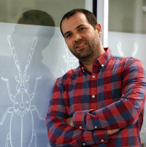BII-MCE Seminar Series
Our weekly seminar series on mechanisms of cellular evolution will feature a mixture of local, national and international speakers that focus on various topics related to evolutionary cell biology. This series will seek to contribute to building a global community of scholars in evolutionary cell biology.
Fall 2024

Anne Spang, PhD
Professor, Biozentrum
Universität Basel
Mechanisms of intracellular communication
Cells need to communicate and interact with the environment. These interactions need to be facilitated through intracellular communication pathways, which comprises biosynthetic and endocytic transport and signaling pathways. In recent years it became clear that besides the classical pathways, organellar contact sites and membrane-less organelles are likewise important players of intracellular communication. Moreover, technological advances allowed a more precise dissection of vesicular transport. The endosomal system is a particular interesting system to study intracellular communication as signals from the plasma membrane converge with biosynthetic route and the information has to be processed correctly. Moreover, the connections between organelles of the biosynthetic route with more metabolic organelles continuous to provide new insights in intracellular communication.
Spring 2024

Tera Levin, PhD
Assistant Professor, Department of Biological Sciences
University of Pittsburgh
The evolution of immunity and bacterial pathogenesis within environmental battlegrounds
While our immune system protects us from most microbes, new pathogens continually emerge from natural environments, bringing with them a suite of virulence factors for attacking host cells. We seek to understand how new pathogen emergence occurs by uncovering the causes and consequences of virulence gene evolution in the wild, with a focus on how eukaryotic predators such as amoeba alter bacterial evolution. We describe a new, experimental evolution approach to uncover the genetic steps that accompany the horizontal acquisition and spread of key virulence genes through bacterial populations. To discover what immune defenses are present in amoeba, we are using deep phylogenomics to trace the origins of important innate immune proteins across the eukaryotic Tree of Life. Together, these experimental and evolutionary approaches allow us to address key questions about how new mechanisms of immunity and pathogenesis arise in nature.

James Letts, PhD
Associate Professor, College of Biological Sciences
UC Davis
A biodiversity approach to understanding respiratory complex I regulation
Respiratory complex I is a proton-pumping oxidoreductase key to bioenergetic metabolism. Biochemical studies have found a divide in the behavior of complex I in metazoans that aligns with the evolutionary split between Protostomia and Deuterostomia. Complex I from Deuterostomia including mammals can adopt a biochemically defined off-pathway ‘deactive’ state, whereas complex I from Protostomia cannot. The presence of off-pathway states complicates the interpretation of structural results and has led to considerable mechanistic debate. Here, I will discuss the structure of mitochondrial complex I from the thoracic muscles of the model protostome Drosophila melanogaster.

Dan Sloan, PhD
Associate Professor, Department of Biology
Colorado State University
Expansion of the MutS gene family shapes plant organelle genetics
Plant mitochondria and plastids exhibit many genetic features that distinguish them from other eukaryotic systems, including exceptionally low point mutation rates, frequent rearrangements in genome structure, and massive levels of protein expression. Compared to other eukaryotes, plants also have a larger complement of nuclear-encoded proteins from the MutS family, with novel members gained through a combination of horizontal gene transfer, endosymbiotic gene transfer, and ancient gene duplications. I will present work by our group and others showing how eukaryotes have evolved such tremendous diversity in organelle genome architecture and function

Joe Parker, PhD
Assistant Professor, Division of Biology and Biological Engineering
California Institute of Technology
Evolutionary paths to organismal and ecological complexity
How does evolution build complexity at the highest of levels, embodied by complex multicellular organisms and, moreover, the ecological relationships that have evolved between them? In this talk, I discuss my laboratory’s work on rove beetles (Staphylinidae): a vast clade of tiny insects that are revealing new insights into the emergence of organismal and ecological complexity.
Fall 2023

Ranjani Murali, PhD
Assistant Professor, Department of Life Sciences
University of Nevada, Las Vegas
Breathing life into microbial evolution: How oxygen shaped the microbial tree of life
Microbial bioenergetics provides a powerful framework with which to understand microbial adaptation to different environments and microbial evolution over geological time. To understand microbial energetic adaptation, we explored patterns of respiratory protein evolution in large metagenomic datasets, within the context of different ecosystems and within a taxonomic framework. Using the phylogenomic distribution of two important respiratory scaffolds – the heme-copper oxidoreductase (HCO) and cytochrome bd oxygen reductase – we discovered novel pathways in aerobic respiration and denitrification. We functionally characterized a new family of nitric oxide reductases (NORs) from one of the new denitrification pathways, and showed that Rhodothermus marinus (a microorganism containing this enzyme) is capable of denitrification. The proposed denitrification pathways significantly increases the number of known denitrifiers in the environment, reshaping our understanding of nitrous oxide (N2O) cycling, a notable greenhouse gas. Our large-scale analysis of the distribution of oxygen reductases also revealed that they are widely distributed in bacteria and archaea and that over 66% of bacteria and archaea are capable of aerobic respiration. We showed also that there are numerous distinct homologs within the HCO and cytbd superfamilies performing oxygen reduction and that microorganisms using these different homologs are adapted to different ecological niches. Our combined framework of phylogenomics, biochemical analysis and environmental microbiology provides a comprehensive picture on the eco-evolutionary adaptation of microorganisms to oxygen in the atmosphere.

Pavel Doležal, PhD
Assistant Professor, BIOCEV
Charles University, Czech Republic
The simplest known mitochondria of the unicellular gut parasite Giardia lamblia
Giardia lamblia is one of the most common parasites of humans. The prevalence in developed countries is estimated to be between 2 and 7%. Although it is so close to us, little is known about the biology of this unicellular anaerobic eukaryote. Recent studies of Giardia metabolism and cell structure have revealed several exciting cellular adaptations that allow the organism to thrive in our gut. The parasite has evolved new cellular organelles, such as the adhesive disc, but has also dramatically modified its mitochondria and the endomembrane system. Our group studies the biology of its miniature mitochondria, known as mitosomes, which represent some of the simplest known mitochondrial compartments. Our data show that they contain only a single metabolic pathway involved in the formation of iron-sulfur (Fe-S) clusters. Aerobes require these cofactors primarily for the respiratory chain, which is absent in Giardia. Thus, we study how the mitosomal synthesis of Fe-S clusters affects the other cellular compartments.Like mitochondria, mitosomes are tightly associated with the endoplasmic reticulum. Their division is fully synchronized with the parasite cell and life cycle and their inheritance is controlled by a specific microtubule connector that links them to flagella. Finally, using Giardia mitosomes as an experimental model we study the evolution of mitochondrion and its core molecular machineries.

Brad Olson, PhD
Associate Professor, Division of Biology
Kansas State University
The simplest known mitochondria of the unicellular gut parasite Giardia lamblia
The evolution of multicellularity is consider a major transition in biology, yet we have a limited understanding of the molecular mechanisms underlying this transition due to the large divergence times between multicellular eukaryotes and their unicellular outgroups. The volvocine algae are a unique model for the study of multicellular evolution because they have recently transitioned to multicellularity (~250 Mya) and member species exhibit a range of phenotypes from unicellular, to undifferentiated and differentiated multicellular. Given their recent transition to multicellularity, the genomes of member species are similar; there are few examples gene duplication and divergence, whereas there is a remarkable and progressive loss of genes as multicellular developmental complexity increases. Notably, member species have repeatedly gained and lost traits associated with multicellular complexity, suggesting multicellular evolution is a dynamic process that may be driven by a small number of co-option events and by loss of gene functions that are no longer needed for multicellularity. When the transcriptomes and proteomes of these organisms are examined, we have found that nearly half of the genes in multicellular species are expressed differently and have novel protein-protein interactions not shared with their unicellular outgroups. Instead, this suggests that alterations in the developmental timing of gene expression gives protein new opportunities for interactions in protein complexes that contribute to multicellular complexity rather than directly encoding these functions in the genome. Finally, multicellularity is often assumed to be a rate limiting step toward developmentally complex organisms. However, in the volvocine algae we have found two ecological stress responses that result in a plastic change to their developmental complexity. First, we have found that unicellular algae can transiently become multicellular when faced with specific environmental stressors such as predation, and second, we have found that undifferentiated algae can conditionally undergo cellular differentiation in response to cold shock. Examination of the molecular basis of these plastic responses indicates overlap with genes known to be important for multicellular evolution, and suggests that multicellular evolution is a continuum of levels of organismal integration that change in response to the environment.
Spring 2023

Brandon Ogbunu, PhD
Assistant Professor, Department of Ecology and Evolutionary Biology
Yale University
Interactions vs. everything: complexity, disease, context, genes…(and the space in between) of (cell) biology are predictable?
In this seminar, I discuss the research interest in higher-order interactions in complex biological systems, using models and data from the evolution of antimicrobial resistance.

Justin Kumar, PhD
Professor, Department of Biology
Indiana University, Bloomington
Graded transcription factor expression mediates the choice between compound eye and ocellar visual systems
This talk discusses recent developments in the understanding of the Pax6 transcription factors Eyeless (Ey) and Twin of Eyeless (Toy) in mediating the development of the visual systems in Drosophila melanogaster.
Fall 2022

Holly Goodson, PhD
Professor, Department of Chemistry and Biochemistry
University of Notre Dame
What aspects of (cell) biology are predictable?
Is biology predictable? More specifically, are aspects of biology predictable, and if so, which ones? Now is the time to revisit this old and contentious problem because of recent advances in fields including complex systems, synthetic biology and the molecular diversity of life. Questions about the potential predictability of living systems can and should be asked at all biological scales. However, since cells exist at the interface between chemistry and biology, one potentially tractable way to phrase this problem is this: How do physics and chemistry (including geochemistry) lead to predictable cell-level characteristics, such as physical structures, metabolic pathways, and/or information processing networks? In considering these questions, it is important to recognize that when physics and chemistry have been invoked to explain biology, the effect has often been phrased in terms of constraints — that physics and chemistry limit biological systems. However, physics and chemistry can also be profoundly creative; the impact of self-organizing processes is seen at scales from the molecular to the ecological. Addressing the problem of predictability in biology should reveal as-yet unrecognized fundamental principles of biology and help inform other fields of science such as nanotechnology. And, since physics and chemistry are universal, they should provide insight into life as it appears elsewhere in the universe.

Navish Wadhwa, PhD
Assistant Professor, Biodesign Center for Mechanisms of Evolution
Arizona State University
Adaptation to physical stimuli — the case of bacterial flagella
Adaptation is a defining feature of living systems. While cellular adaptation to biochemical stimuli is well studied, how cells adapt to their mechanical environment is poorly understood. I will discuss our attempts to address this gap by studying the flagellar motor, a macromolecular machine that powers swimming in bacteria. This biological nanomachine autonomously adapts to changes in mechanical load by adding or removing force-generating “stator” units. To reveal the physical and molecular mechanisms underlying mechano-adaptation, we used electrorotation, a technique in which a rapidly rotating electric field applies an external torque on single cells. With this method, we could change motor load at will and measure the resulting stator dynamics at high temporal resolution. By combining single-motor experiments with theoretical modeling, we discovered that the force generated by the stator units controls their unbinding, forming a feedback loop that leads to autoregulation of the assembly. Adaptive remodeling of the motor takes place within seconds, making it a highly responsive autonomous control mechanism.